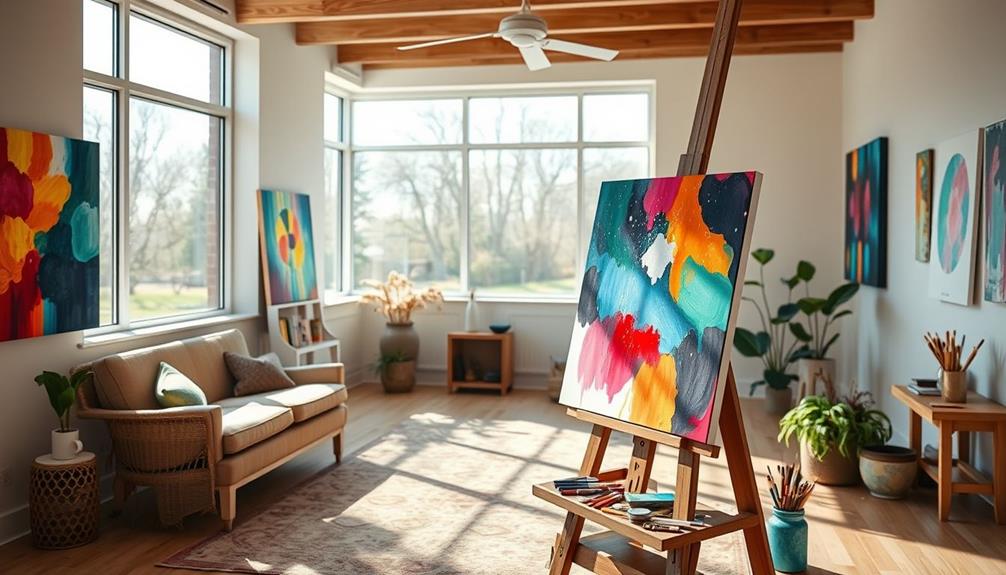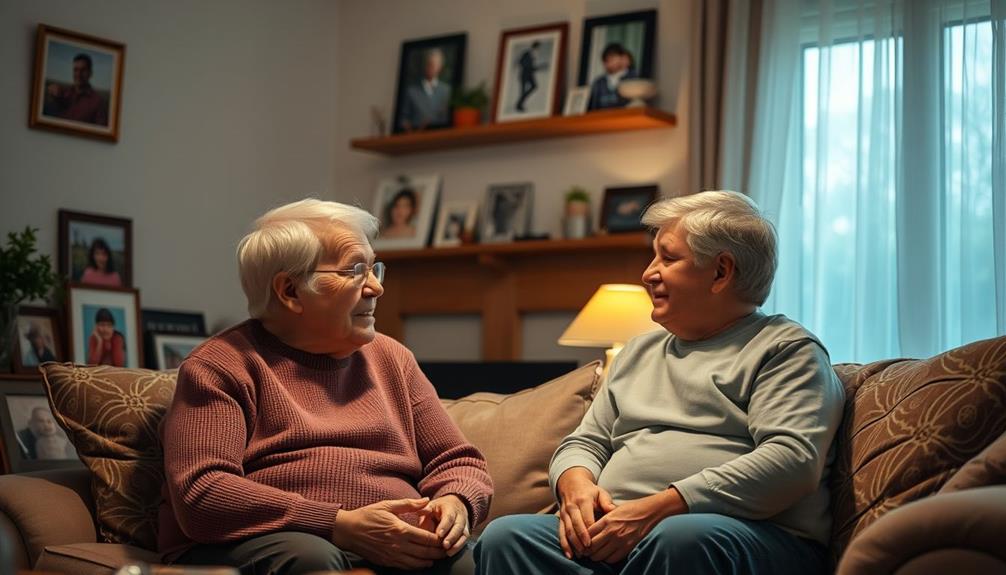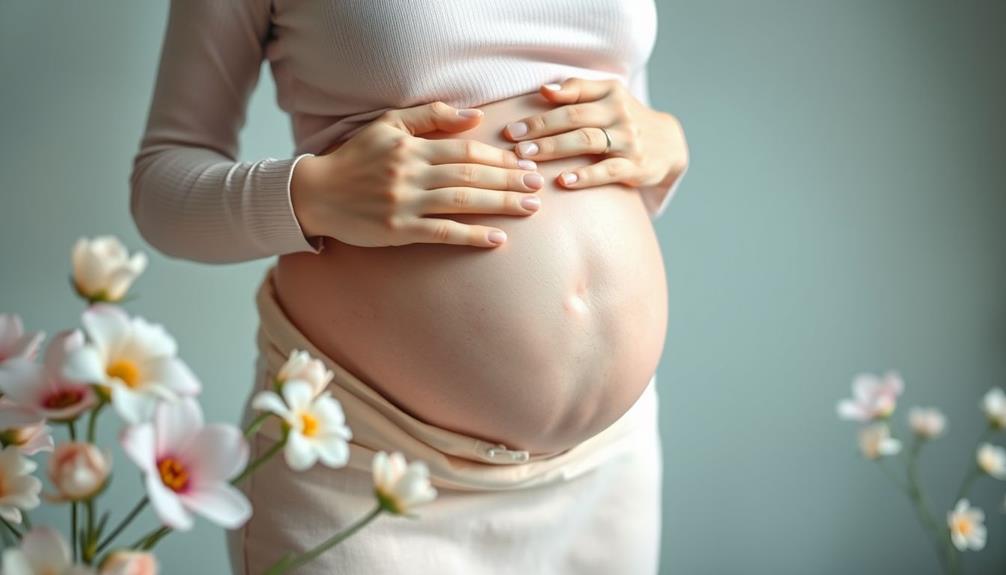Art therapy plays a crucial role in treating Borderline Personality Disorder (BPD) by enhancing emotional expression and coping skills through creative processes. You engage with various art mediums, which helps you communicate difficult feelings in a safe space. Techniques like layered collages and group art sessions promote connection and self-empowerment. This therapy aligns with Dialectical Behavior Therapy principles, fostering mindfulness and emotional regulation. Many participants report improved self-image and interpersonal skills over time. Overall, art therapy creates a supportive environment for healing, making significant strides in emotional well-being. There's much more to uncover about its transformative impact.
Key Takeaways
- Art therapy provides a creative outlet for emotional expression, aiding individuals with BPD in managing intense feelings and enhancing emotional regulation.
- The integration of Dialectical Behavior Therapy (DBT) principles in art therapy promotes mindfulness and personal growth, crucial for BPD treatment.
- Participants in art therapy often report improved self-image, interpersonal skills, and overall well-being, indicating significant therapeutic benefits.
- Non-verbal communication through art facilitates the exploration of complex emotions, making it easier for patients to articulate difficult feelings.
- Ongoing research is needed to further understand the impact of art therapy on BPD treatment outcomes and patient engagement.
Overview of BPD
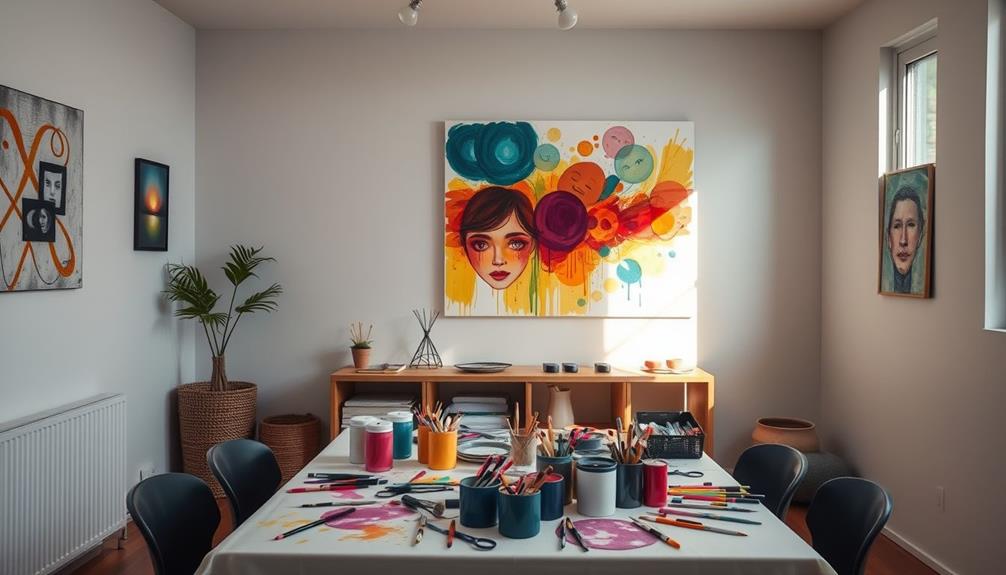
Borderline Personality Disorder (BPD) considerably impacts both individuals and their loved ones. This complex mental health condition affects approximately 2-4% of the general population, leading to instability in emotional regulation, self-image, and interpersonal relationships.
If you or someone you know deals with BPD, you may recognize the intense emotional reactions that make it difficult to manage relationships and effectively express emotions. Many individuals with BPD experience challenges like impulsivity and communication difficulties, which can complicate their ability to share their inner experiences.
These struggles often stem from underlying trauma and may coexist with other conditions such as PTSD, and this emotional dysregulation is a key characteristic of BPD emotional dysregulation. As a result, coping skills become essential for maneuvering everyday life.
It's important to understand that BPD not only affects those diagnosed but also greatly burdens mental health services, accounting for 20% of inpatient and 15% of outpatient care.
Understanding Art Therapy
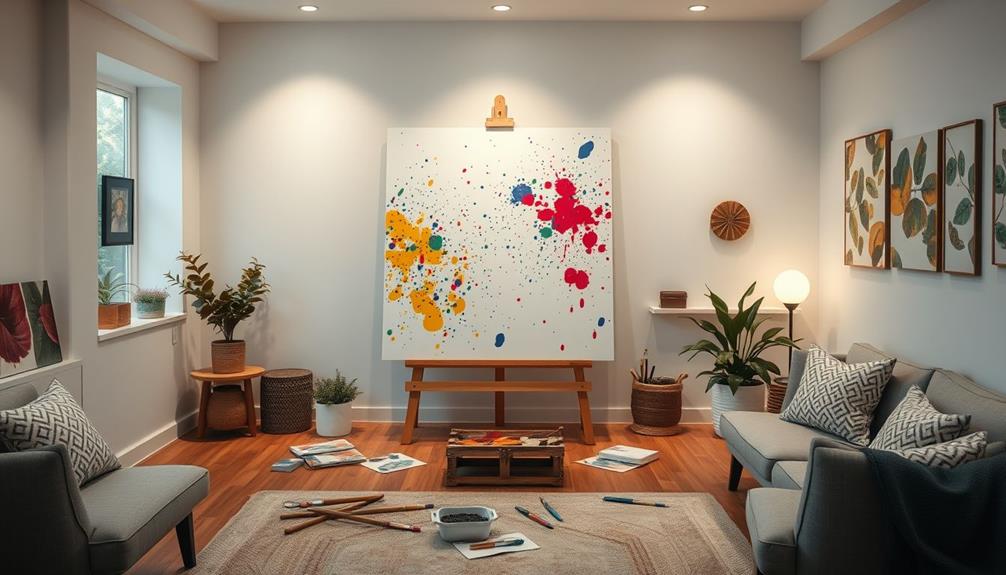
Art therapy combines creative expression with therapeutic techniques to help you explore your emotions and improve self-awareness.
Its purpose is to provide a safe space for you to communicate feelings that might be hard to express verbally.
Through structured sessions, you'll engage in activities that foster emotional regulation and build coping skills.
Additionally, incorporating sensory elements such as essential oils can enhance the therapeutic experience, promoting relaxation and emotional balance, as seen in essential oils for calming.
Definition and Purpose
Creative expression serves as a powerful tool in therapy, especially for those grappling with emotional challenges. Art therapy harnesses the creative process to help you express emotions, explore feelings, and enhance self-awareness. This approach is particularly beneficial for individuals facing Borderline Personality Disorder (BPD), as it fosters emotional regulation and coping strategies.
Here's a concise overview of the key components of art therapy:
| Component | Description | Benefits |
|---|---|---|
| Emotional Expression | Utilizes various art mediums to convey complex feelings | Helps articulate emotions difficult to verbalize |
| Safe Environment | Structured sessions create a supportive space | Promotes emotional regulation and healing |
| Self-Exploration | Encourages insight into personal experiences and feelings | Enhances self-awareness and personal growth |
Research shows that art therapy substantially improves emotional functioning and self-image, aligning with Dialectical Behavior Therapy (DBT) principles. It encourages mindfulness and acceptance, ultimately fostering a healing journey through creativity, making it an essential aspect of mental health care for those with BPD.
Therapeutic Techniques Used
When exploring therapeutic techniques in art therapy, you'll find a variety of methods designed to facilitate emotional expression and self-discovery. For individuals with Borderline Personality Disorder (BPD), these techniques are particularly powerful.
Structured sessions often incorporate specific interventions like the Strength Medallion and Layered Collage, which encourage self-reflection and emotional processing. Additionally, incorporating elements of cold medications overview can foster a holistic approach to managing emotional distress, helping to alleviate some symptoms that may interfere with therapy.
The therapeutic environment plays an essential role, emphasizing a non-judgmental attitude from therapists. This approach helps you feel safe to explore complex feelings that may be hard to articulate verbally.
Integrating Dialectical Behavior Therapy (DBT) principles into art therapy enhances the experience, allowing you to practice emotional regulation and mindfulness through creative expression.
As you engage in these therapeutic techniques, you'll likely notice improvements in emotional functioning and interpersonal skills. Regular participation in art therapy can greatly enhance your ability to express emotions and regulate them more effectively.
Benefits of Art Therapy
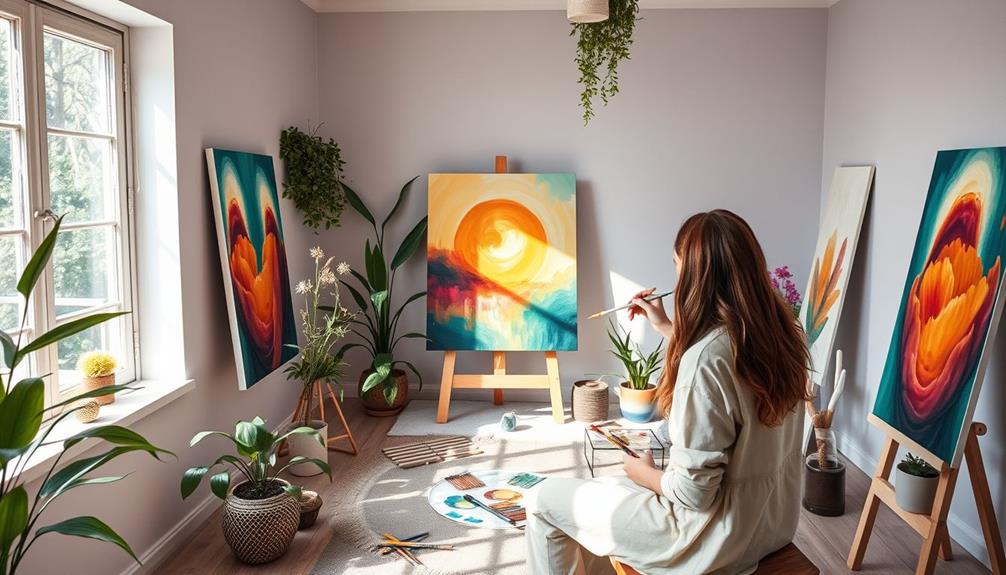
One significant benefit of art therapy for individuals with Borderline Personality Disorder (BPD) is its ability to enhance emotional functioning. Research shows that after three months of art therapy, participants experience a notable increase in emotional benefits, rising from 25.2% to 31.8%. The creative process involved in art therapy offers a constructive outlet for managing emotional dysregulation, which is essential for guiding the intense feelings often associated with BPD.
Additionally, art therapy can foster development in key areas such as emotional and psychological growth, paralleling the key domains of development in psychology.
Moreover, art therapy helps improve your self-image and personal insight, leading to higher social functioning scores—averaging 3.70 out of 5. You'll also notice an increase in interpersonal effectiveness and relationship skills, addressing the interpersonal challenges that accompany BPD. Curiously, male participants often report even greater improvements in social functioning compared to females.
The supportive therapeutic environment plays a key role in these benefits. The non-judgmental attitude of therapists creates a safe space for emotional expression, which correlates strongly with positive outcomes.
In fact, there's a significant relationship between emotional expression in your artwork and the overall benefits you experience, with a correlation of r = 0.72.
Art Therapy Techniques
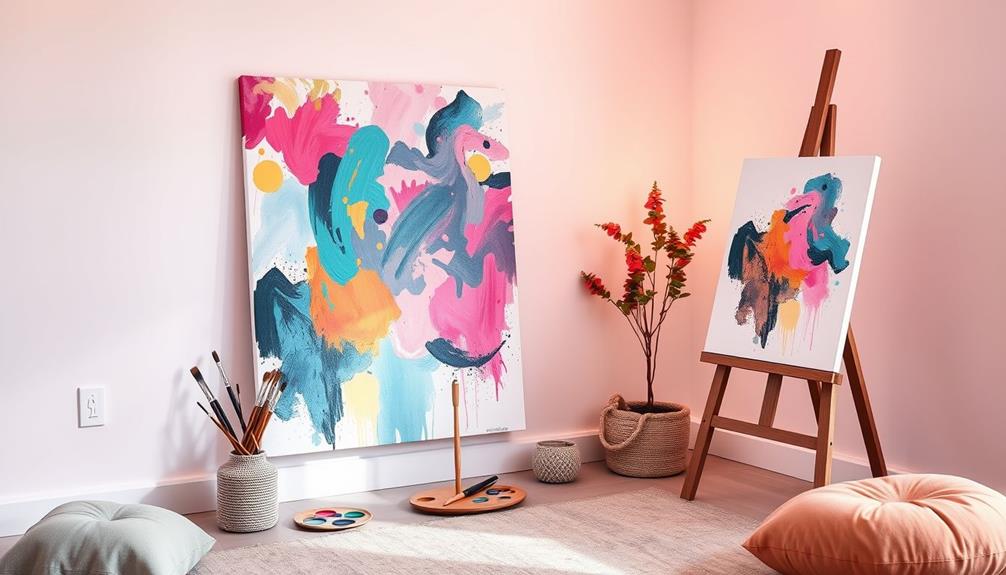
Numerous art therapy techniques are specifically designed to support individuals with Borderline Personality Disorder (BPD) in their healing journey. These techniques encourage you to explore your emotions and foster skills like emotional regulation and distress tolerance, emphasizing the significance of creative expression and imagination in art as a pathway to understanding oneself.
Here are three impactful techniques:
- Strength Medallion: This project helps you identify and visualize your strengths, promoting self-empowerment and a positive self-image.
- Layered Collage: Through layering different materials, you can express complex feelings and experiences, allowing for deeper self-reflection and emotional processing.
- Group Art Therapy: In a supportive environment, you can engage in structured sessions that include skill presentations followed by art-making, fostering connection and shared understanding.
These methods often utilize non-verbal communication, allowing you to express feelings that might be hard to articulate. Grounded in Dialectical Behavior Therapy (DBT), they create a safe space for exploration.
The variety of art materials promotes personal choice, crucial for managing emotional dysregulation. By participating in these techniques, you'll not only enhance your emotional skills but also build a stronger connection with yourself and others.
Role of DBT in Art Therapy
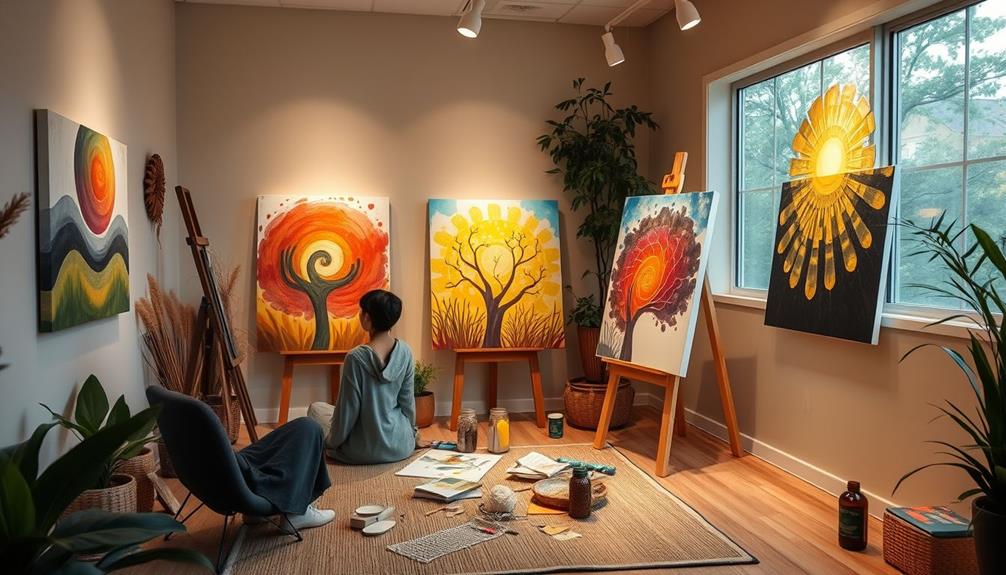
In art therapy, DBT plays an essential role by teaching you mindfulness and emotional regulation techniques that enhance your creative expression.
This approach not only fuels personal growth but also taps into the benefits of curiosity, allowing you to explore your feelings in a safe and constructive way.
By incorporating these skills into your art practice, you can better manage intense emotions and improve self-awareness.
This combination not only fosters personal growth but also allows you to explore your feelings in a safe and constructive way.
Mindfulness and Emotional Regulation
Art therapy, grounded in the principles of Dialectical Behavior Therapy (DBT), offers a powerful approach to enhancing mindfulness and emotional regulation for individuals with Borderline Personality Disorder (BPD). By engaging with art, you can cultivate a deeper self-awareness and learn to navigate your emotions effectively.
In addition to fostering emotional growth, this therapeutic approach can highlight the importance of creating a personal budget for managing finances, which may also contribute to overall well-being. Mindfulness, a core component of DBT, encourages you to stay present, making it easier to recognize and accept your feelings without judgment.
Through art therapy, you'll experience several benefits:
- Increased self-awareness: As you create, you'll uncover hidden emotions and thoughts, fostering a better understanding of yourself.
- Improved emotional regulation: Art-making allows you to express feelings that might be overwhelming, helping you manage your emotional responses in healthier ways.
- Supportive environment: You'll be in a safe space where you can practice DBT skills, such as distress tolerance, while expressing yourself artistically.
Research shows that this combined approach greatly improves emotional regulation, making art therapy an essential tool for those with BPD. Embracing mindfulness in your creative journey can lead to healthier coping mechanisms and emotional expression.
Creative Expression Techniques
Creative expression techniques, rooted in the principles of Dialectical Behavior Therapy (DBT), empower you to articulate emotions and thoughts that might otherwise feel overwhelming. By integrating DBT skills like mindfulness, distress tolerance, and emotional regulation into art therapy, you create a space for self-awareness and self-acceptance through creative expression.
Engaging in activities such as gentle stretching before bedtime can also complement your art therapy by promoting relaxation and emotional clarity.
One effective intervention is the "Wise Mind Book," where you engage in a simple accordion book-making process. This encourages you to explore your emotions and thoughts, promoting reflection and insight into your personal experiences.
Structured art therapy sessions, guided by DBT principles, provide a safe environment for you to visualize and articulate your emotions, enhancing your overall emotional regulation and self-understanding.
Research supports the impact of art therapy combined with DBT, showing significant improvements in emotion regulation for those with Borderline Personality Disorder (BPD). Participants typically report a Cohen's d of 1.77 in their progress.
Patient Experiences and Insights
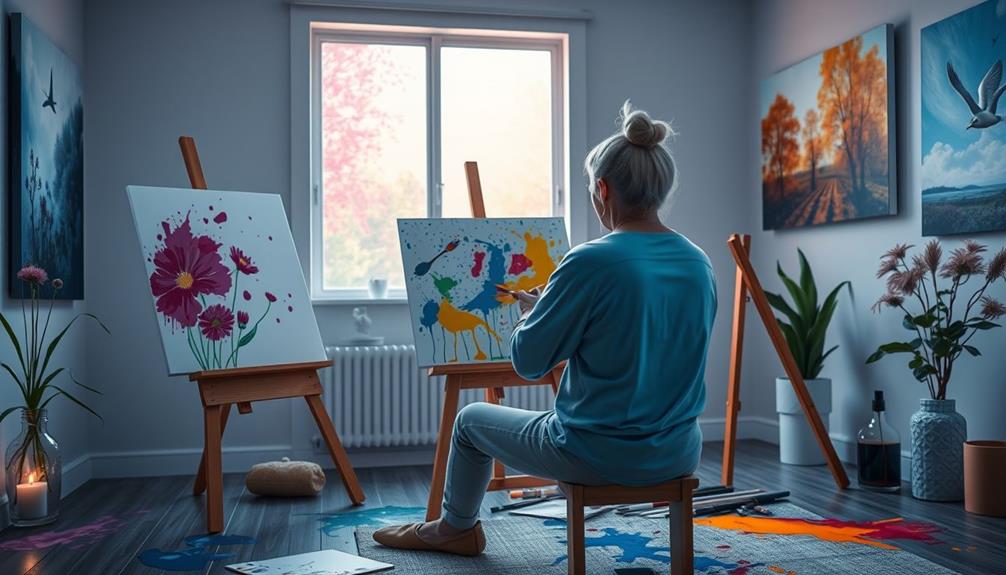
Many patients have shared powerful insights about their experiences with art therapy in treating Borderline Personality Disorder (BPD). You might find it inspiring to learn that many participants reported significant improvements in their emotional regulation and self-understanding through the creative process, often reflecting on the importance of heartfelt expressions of love in their healing journey.
Here are three key benefits of art therapy that resonate deeply with those who've participated:
- Enhanced Emotional Expression: The non-verbal nature of art therapy allows you to communicate complex feelings that words often fail to capture.
- Development of Coping Skills: Many have found that engaging in a skills group focused on art provides effective strategies for managing emotional dysregulation, leading to a more balanced life.
- Increased Well-Being: Remarkably, 77.4% of participants noted a boost in their overall well-being after the program, highlighting the transformative power of art therapy.
Working with an art therapist, you can explore your emotions in a safe space, ultimately enhancing your quality of life.
The experiences shared by others underline the profound benefits of art therapy in addressing the challenges of complex mental health issues like BPD.
Future Directions in Research

Exploring patient experiences with art therapy reveals valuable insights, yet there's still much to learn about its effectiveness for individuals with BPD. Future research should focus on identifying specific treatment goals within art therapy that directly impact therapeutic outcomes and the overall patient experience.
The American Art Therapy Association emphasizes the need for studies that examine how therapist attributes, such as attitude and approach, influence patient engagement and the efficacy of interventions for Borderline Personality Disorder (BPD). Additionally, effective strategies for weight loss and lifestyle adjustments for longevity could also play a role in the overall well-being of patients, suggesting a multifaceted approach to treatment sustainable weight loss strategies.
Considering demographic factors like age and gender could provide a clearer understanding of how these elements affect the effectiveness of art therapy.
It's also essential to explore the role of peer-led art therapy programs in enhancing coping skills and offering validation to individuals grappling with emotional dysregulation and identity disturbances.
Ongoing research should refine art therapy approaches to guarantee they adequately address these common challenges faced by BPD patients. By delving deeper into these areas, we can better tailor art therapy practices to meet the unique needs of those with BPD, ultimately improving their therapeutic journey and outcomes.
Conclusion
In the journey of healing from BPD, art therapy serves as a guiding light, illuminating paths that were once shrouded in darkness. It offers a canvas for self-expression, helping you to paint over the chaos of emotions with colors of understanding and hope. As you embrace these creative techniques, remember that each brushstroke is a step toward clarity and connection. With continued research and practice, this vibrant approach can transform lives, creating masterpieces of resilience and recovery.
